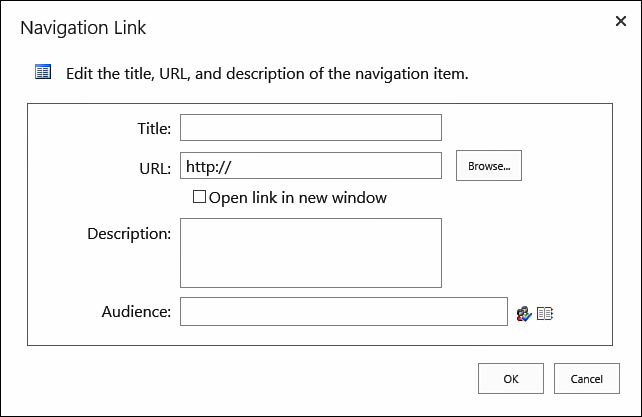Use Structural Navigation to Add a Link to the Top or Left Navigation Bar
To add a link to either navigation bar, after
selecting to use Structural Navigation, scroll down and locate the
Structural Navigation: Editing and Sorting section of the page, and
click the Global Navigation node (for the top navigation bar) or
Current Navigation node (for the left navigation bar) in the Navigation
Editing and Sorting box. Click the Add Link option in the menu. This
selection opens a dialog where you can specify the link to be added
(see Figure 5).

FIGURE 5 Adding a link to a navigation bar.
In the Title box, you
can specify what text the link displays to the user. Also, you can
either type in a link or browse to a page in the site by using the
Browse button. You can also specify whether the link is opened in a new
window when clicked. In sites where it is enabled, you can choose an
audience for the link, specifying who should see the link.
Add a Heading to the Top or Left Navigation Bar
In a publishing site, you can add headings to
both the top and left navigation bars. A heading in a publishing site
can be a link or just text that can have other links under it.
Note
In a publishing site the heading doesn’t have
to be a link. Instead, a heading can just be a container for links,
without allowing users to click it in the navigation bar.
To add a heading, simply click the Global
Navigation node (for the top navigation bar) or Current Navigation node
in the Navigation Editing and Sorting box, and then click the Add
Heading button in the menu. The dialog that pops up is the same as the
one for adding a link (refer to Figure 5), but unlike with adding a link, in this case you can keep the URL setting empty if you don’t want the heading to be a link.
Edit a Link or a Heading in the Top or Left Navigation Bar
To edit a link or heading from either
navigation bar, click the link or heading in the Navigation Editing and
Sorting box, and then click the Edit button on the toolbar. The dialog
for the link’s setting opens, allowing you to specify how this link
should behave (refer to Figure 5).
Remove a Link from the Top or Left Navigation Bar
To remove a link from either navigation bar,
click the link in the Navigation Editing and Sorting box, and then
click the Delete button on the toolbar.
Change Which Heading a Link Is Under
To select the heading for a link in a
publishing site, move the link up or down in the Navigation Editing and
Sorting box until it is under the heading you want. Select the link,
and then use the Move Up and Move Down buttons to move the link in or
out of headings.
Note
You can have a link exist in the
root (not under a heading). Simply move the link to be under either
Current Navigation or Global Navigation.